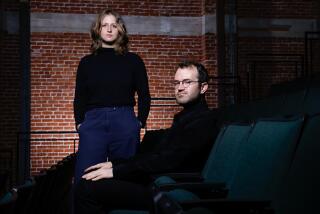Off-Centerpiece : A: “South Central” (Q: What Movie Didn’t Open in L.A.?)
In one of the more fortuitous strokes of fate, “South Central,” the latest film set in the largely black and Hispanic section of Los Angeles, has a title people almost anywhere in the world with access to CNN could relate to after the riots last spring.
But Warner Bros., which acquired the film for theatrical distribution from the now-defunct RCA-Columbia home video unit, opened “South Central” where last Friday? Baltimore, Washington and Chicago.
“(The studio) felt the title could be construed to be incendiary,” said writer-director Steve Anderson. “If the movie is given a platform to build outside the city, fine!”
Actually, the movie has nothing to do with the riots. Adapted from L.A. high school teacher Donald Bakeer’s book “Crips,” the film concerns one father’s attempt to reverse for his 8-year-old son the inner-city criminal cycle of gangs, murder and prison that the lead character, Bobby, has already experienced by his early 20s. Glenn Plummer plays Bobby and Bryon Keith Minns is Ray Ray, a manipulative gang leader; Carl Lumbly plays Ali, a Muslim fellow prisoner who turns Bobby’s life around.
Warners plans to open the picture here and in New York on Oct. 16 following positive reviews and commercial success in the other cities.
“News reports tried to tell us what happened in Los Angeles, but failed because they are limited to the facts. Movies like this one let us feel the emotion,” said Chicago Sun-Times critic Roger Ebert in his three-star review. There were also raves from Variety’s Joe McBride and the Chicago Tribune’s Dave Kehr. “South Central” grossed $147,600 on 37 screens during its opening weekend--a per screen average of $3,990, or equal to that of “Sneakers,” the country’s No. 1 movie.
Anderson’s debut feature followed the good critical reception to “Hearts of Stone,” a short film about L.A. gangs that he showed at the Sundance Film Festival in 1989. Oliver Stone was so impressed that he became executive producer on “South Central” and championed it around town.
Janet Yang, a development executive at Stone’s Ixtlan Films and the film’s producer, said the movie was developed by Fox, put into turnaround following the violence associated with “New Jack City” and then, after scores of refusals, was made for $2 million by RCA-Columbia, once the low-budget arm of Columbia Pictures.
“Pick a reason. We heard them all. Some people had some fears about a black film being made by a white director, that there might be a conflict with another project and maybe some incidents at theaters,” she said. “But after the film was made, if there were ever moments of doubt, they were erased.”
She said once Arnon Milchan, executive producer of Stone’s “JFK,” bought the foreign rights, Warners got serious about negotiating domestic theatrical rights.
Concerns that “South Central” would provoke violence are unfounded, which doesn’t surprise the filmmakers. They acknowledge it has some inflammatory scenes, that they are countered by the film’s theme, which advocates ending gang warfare.
“I know more about Crips than any Crip,” said Bakeer, who conducted 500 interviews with gang members for his book and is a teacher at Washington High School in south Los Angeles. “I know how they act and react. I know how to cool them down. I’m certain this is going to be a very, very positive experience for them. They’re at peace with the Bloods right now aren’t they?” (The Crips are called Deuces in the movie. In real life, the Crips and Bloods have called a truce following the riots.)
Last week, Warners sent Bakeer and Anderson to Washington to conduct a special screening at an all-black high school. The movie received a standing ovation and Anderson, who felt vulnerable to criticism as the white director of a black story, said none of the students challenged him on that issue. (A similar screening is planned for the student body at Washington High, Bakeer’s school.)
It wasn’t lost on Anderson that recent films set in South-Central L.A.--notably “Boyz N the Hood” and “House Party”--were directed by black men. While shooting “South Central” on location in and around Los Angeles, Anderson cast Crips as extras and, more importantly for the film, solicited the input of his all-black cast to the film’s dialogue.
“I do not profess that this is a great film,” he said. “But it has heart and I hope that’s what audiences will respond to.”
More to Read
Only good movies
Get the Indie Focus newsletter, Mark Olsen's weekly guide to the world of cinema.
You may occasionally receive promotional content from the Los Angeles Times.








